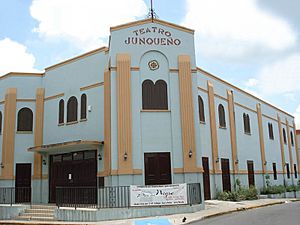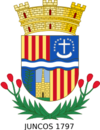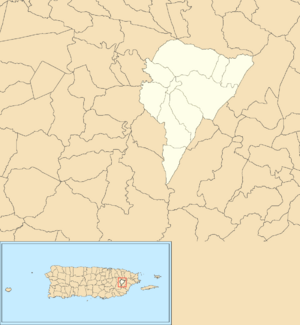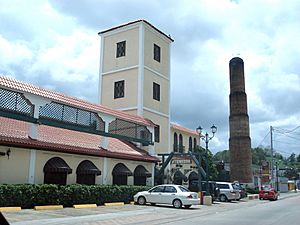Juncos, Puerto Rico facts for kids
Quick facts for kids
Juncos
Municipio Autónomo de Juncos
|
|||
|---|---|---|---|
|
Town and Municipality
|
|||

Theater in Juncos
|
|||
|
|||
| Nicknames:
"La Ciudad del Valenciano", "Los Mulos del Valenciano"
|
|||
| Anthem: "Juncos Mi Pequeño París" | |||

Map of Puerto Rico highlighting Juncos Municipality
|
|||
| Sovereign state | United States | ||
| Commonwealth | Puerto Rico | ||
| Settled | 1792 | ||
| Founded | August 2, 1797 | ||
| Founded by | Tomás Pizarro | ||
| Barrios | |||
| Area | |||
| • Total | 26.60 sq mi (68.89 km2) | ||
| • Land | 26.59 sq mi (68.86 km2) | ||
| • Water | 0.01 sq mi (0.03 km2) | ||
| Population
(2020)
|
|||
| • Total | 37,012 | ||
| • Rank | 29th in Puerto Rico | ||
| • Density | 1,391.50/sq mi (537.26/km2) | ||
| Demonym(s) | Junqueño | ||
| Ethnicity | |||
| • White | 93.5% | ||
| • Black | 7.2% | ||
| • American Indian/AN | 0.0% | ||
| • Asian | 0.0% | ||
| • Native Hawaiian/PI | 0.0% | ||
| Time zone | UTC-4 (AST) | ||
| ZIP Code |
00777
|
||
| Area code(s) | 787/939 | ||
| Major routes | |||
Juncos is a town and one of the 78 municipalities of Puerto Rico. It is located in the eastern central part of the island. Juncos is west of the Caguas Valley. It is south of Canóvanas and Carolina. It is also southeast of Gurabo, east of San Lorenzo, and west of Las Piedras.
The town of Juncos is divided into 9 areas called barrios, plus the downtown area. The downtown area is known as Juncos barrio-pueblo. Juncos is part of the larger San Juan-Caguas-Guaynabo Metropolitan Statistical Area.
Juncos was officially founded on August 2, 1797. It started as a small ranch called Hatillo de los Juncos. This ranch was part of a bigger area known as Hato del Valenciano. The Río Valenciano river, which flows through the city, gets its name from this old ranch.
The word Juncos means "reeds" in Spanish. Reeds are tall, grass-like plants that grow in wet places.
Contents
History of Juncos
During the 1600s, much of the land in Juncos belonged to large ranches. One of these was the Hato del Valenciano. This ranch was later split into smaller parts. One part, the Hatillo de los Juncos, grew into the village of Juncos. It officially became a town on August 2, 1797.
The name "Juncos" comes from the reeds that grew in the area. These reeds are even shown on the town's flag and coat of arms. The old Hato del Valenciano ranch is remembered in the name of the Río Valenciano river. It also inspired Juncos' nicknames: "La Ciudad del Valenciano" (The Valenciano City) and "Los Mulos del Valenciano" (The Valenciano's Mules).
After the Spanish–American War in 1898, Puerto Rico became a territory of the United States. In 1899, a count of the population showed that Juncos had 8,429 people.
On September 20, 2017, Hurricane Maria hit Puerto Rico very hard. Juncos had already been declared a disaster zone a week earlier due to Hurricane Irma. Hurricane Maria caused about $25 million in damage to homes and buildings. The strong winds and heavy rain also caused many landslides in Juncos.
Symbols of Juncos
The town of Juncos has its own official flag and a special design called a coat of arms.
Juncos Flag Design
The flag of Juncos has a gold background. In the lower half, there are blue wavy stripes that go across. These stripes stand for the Río Valenciano river, which flows through the town. In the middle of the flag, above the stripes, you can see green reeds with red buds. These reeds represent the town's name, as Juncos means "reeds" in Spanish.
Juncos Coat of Arms Meaning
Juncos' coat of arms is divided into four sections. The top left and bottom right sections have gold and red stripes. These stripes are a nod to the Spanish region of Valencia. They also connect to Juncos' nickname, "Town of Valencia."
The top right section is blue and has twelve silver stars. These stars represent the Virgin Mary. This section also includes a cross, showing that the town is part of Christendom. The bottom left section is split. One side shows a tobacco plant, which represents the town's farming history. The other side has a chimney, symbolizing factories and the processing of sugar cane. Just like on the flag, a wavy blue line crosses the shield. This line represents the Río Valenciano river.
On top of the shield is a crown shaped like a castle with three towers. Below the shield, you can see the green reeds with red buds that gave the town its name. The year 1797, when Juncos was founded, is also shown at the very bottom.
Geography of Juncos
Juncos is located in the central eastern part of Puerto Rico.
Barrios of Juncos
Like all towns in Puerto Rico, Juncos is divided into smaller areas called barrios. The main town buildings, the central square, and a large Catholic church are in the middle of the municipality. This area is called "el pueblo".
Sectors within Barrios
Barrios are further divided into even smaller areas called sectores (which means sectors in English). These sectors can have different names, like urbanización (urbanization) or residencial (residential area).
Special Communities in Juncos
Some communities in Puerto Rico are called Comunidades Especiales de Puerto Rico (Special Communities of Puerto Rico). These are areas where people might need extra support. In 2014, some of these special communities in Juncos included: Flores, Santana 1 in Ceiba Norte, Canta Gallo, El Caracol, La Cuesta in Sector El Mangó, La Hormiga, Lirios Dorados in Hoyo Hondo, and Rosalía in Sector El Mangó.
Juncos Climate
| Climate data for Juncos, Puerto Rico (1991–2020 normals, extremes 1931–present) | |||||||||||||
|---|---|---|---|---|---|---|---|---|---|---|---|---|---|
| Month | Jan | Feb | Mar | Apr | May | Jun | Jul | Aug | Sep | Oct | Nov | Dec | Year |
| Record high °F (°C) | 96 (36) |
95 (35) |
94 (34) |
96 (36) |
97 (36) |
96 (36) |
100 (38) |
98 (37) |
99 (37) |
97 (36) |
96 (36) |
98 (37) |
100 (38) |
| Mean daily maximum °F (°C) | 82.3 (27.9) |
82.8 (28.2) |
83.6 (28.7) |
85.1 (29.5) |
86.1 (30.1) |
87.5 (30.8) |
88.1 (31.2) |
88.5 (31.4) |
88.5 (31.4) |
87.3 (30.7) |
85.0 (29.4) |
83.0 (28.3) |
85.6 (29.8) |
| Daily mean °F (°C) | 73.6 (23.1) |
73.7 (23.2) |
74.5 (23.6) |
76.4 (24.7) |
78.4 (25.8) |
79.9 (26.6) |
80.1 (26.7) |
80.4 (26.9) |
80.3 (26.8) |
79.2 (26.2) |
77.1 (25.1) |
74.7 (23.7) |
77.4 (25.2) |
| Mean daily minimum °F (°C) | 65.0 (18.3) |
64.7 (18.2) |
65.4 (18.6) |
67.6 (19.8) |
70.6 (21.4) |
72.2 (22.3) |
72.2 (22.3) |
72.3 (22.4) |
72.0 (22.2) |
71.1 (21.7) |
69.2 (20.7) |
66.4 (19.1) |
69.1 (20.6) |
| Record low °F (°C) | 50 (10) |
50 (10) |
50 (10) |
50 (10) |
50 (10) |
58 (14) |
57 (14) |
58 (14) |
56 (13) |
55 (13) |
51 (11) |
42 (6) |
42 (6) |
| Average precipitation inches (mm) | 3.27 (83) |
2.48 (63) |
2.86 (73) |
4.78 (121) |
6.39 (162) |
5.24 (133) |
7.04 (179) |
7.22 (183) |
8.73 (222) |
7.60 (193) |
7.69 (195) |
4.17 (106) |
67.47 (1,714) |
| Average precipitation days (≥ 0.01 in) | 16.0 | 14.0 | 11.8 | 12.8 | 17.0 | 15.3 | 16.4 | 16.5 | 16.4 | 16.6 | 18.8 | 17.5 | 189.1 |
| Source: NOAA | |||||||||||||
Population of Juncos
| Historical population | |||
|---|---|---|---|
| Census | Pop. | %± | |
| 1900 | 8,429 | — | |
| 1910 | 11,692 | 38.7% | |
| 1920 | 13,151 | 12.5% | |
| 1930 | 17,469 | 32.8% | |
| 1940 | 19,464 | 11.4% | |
| 1950 | 21,654 | 11.3% | |
| 1960 | 21,496 | −0.7% | |
| 1970 | 21,814 | 1.5% | |
| 1980 | 25,397 | 16.4% | |
| 1990 | 30,612 | 20.5% | |
| 2000 | 36,452 | 19.1% | |
| 2010 | 40,290 | 10.5% | |
| 2020 | 37,012 | −8.1% | |
| U.S. Decennial Census 1899 (shown as 1900) 1910–1930 1930–1950 1960–2000 2010 2020 |
|||
The population of Juncos has grown quite a bit over the years. In 1900, there were about 8,429 people living there. By 2020, the population had grown to 37,012 people.
Things to See and Do in Juncos
Juncos has several interesting places to visit:
- Juncos Sugar Mill (an old factory that processed sugar cane)
- Old Tobacco Farm
- Juncos Plaza Shopping Center
- Paseo Escuté (a walking area)
- El Tenedor Restaurant
- Casa Vieja Cafe
- Teatro Junqueño (Juncos Theater)
Culture and Events
Festivals and Celebrations in Juncos
Juncos celebrates its patron saint festival in December. This event is called the Fiestas Patronales Inmaculada Concepcion de Maria. It is a religious and cultural celebration. You can usually find parades, games, local crafts, fun rides, delicious regional food, and live entertainment.
Other fun festivals and events in Juncos include:
- Modesto Carrión International Marathon – held in November
- La Mina Christian Music fest – held in July
- Plenazo Junqueño – held in February
Economy of Juncos
The fertile plains near the Río Valenciano river are good for growing crops. Farmers in Juncos grow coffee, fruits, sugar cane, and tobacco. The town's coat of arms even shows tobacco plants and a chimney from a sugar cane processing factory.
Juncos also has many different industries. These include companies that make clothing, electronic machines, electrical equipment, and scientific tools. There are also pharmaceutical and biotechnology companies.
Amgen, a large biopharmaceutical company, has its biggest manufacturing site in Juncos. This campus makes important medicines and has laboratories. It employs almost 3,000 people. Other companies like Medtronic and Becton Dickinson Caribe Ltd. also have facilities in Juncos.
Transportation in Juncos
Juncos has 28 bridges. The town also has a special transportation system called a "ferry-on-wheels." This system helps people get around the town.
Sports in Juncos
Juncos has a rich sports history. Roberto Clemente Walker, a famous baseball player who won the World Series with the Pittsburgh Pirates, played baseball for Juncos early in his career.
Like in many parts of Puerto Rico, volleyball and basketball are very popular sports in Juncos. In 2006–2007, the Valencianas de Juncos teams won national championships in both women's basketball and volleyball.
In 2009, Juncos became the home of the Puerto Rico Soccer League champions, Sevilla Bayamon FC. The team is now known as Sevilla-FC Juncos. They play their games at the Alfredo "Papo" Alejandro Stadium.
Famous People from Juncos
Many notable people were born in or have ties to Juncos, including:
- Félix Conde Falcón
- Gisselle
- Rita Moreno
- Alfredo Alejandro Carrión
- Rafael Celestino Benítez
- Juan Manuel López (boxer)
- Felicitas Mendez
- María de Lourdes Ramos Rivera
- José Luis Moneró
- Jon Z
- Ele A El Dominio
See also
 In Spanish: Juncos para niños
In Spanish: Juncos para niños





